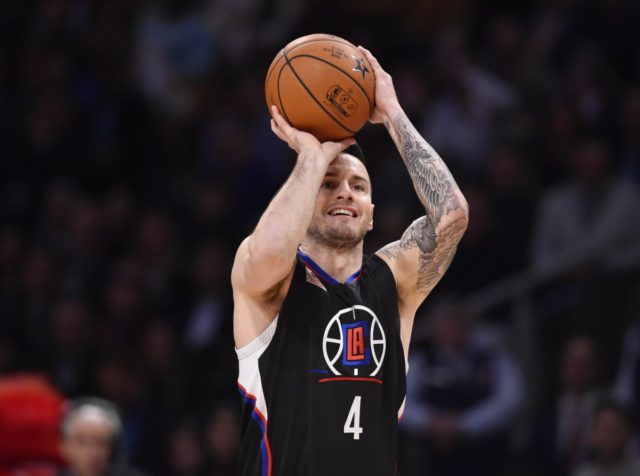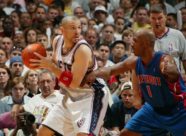The NBA is a big, bad, cruel world. Ir simply doesn’t care whether you’re a top dog in high school, in college, wherever. And it certainly doesn’t give a damn whether you can pull off a 1,080-degree dunk (although that will look good on SportsCenter). What ultimately matters is how you fit into a system and if you don’t, then it’s the other way around: Transforming your game to be more successful.
Here are 6 recent NBA players who have been there and done that.
1. J.J. Redick

Redick was so good in college his jersey was one of only 13 Duke has retired throughout the school’s rich basketball history. Averaging almost 27 points his senior year, Redick can basically do anything when it comes to putting that ball through the hoop. However, Redick is not exactly the most athletically and physically gifted guy out there on the floor. (At 6-foot-4 with a 6-foot-3 wingspan, Redick was labeled a defensive liability upon his entry to the NBA Draft.)
To his credit, J.J. saw what was coming. “I think I’ll be a role player like 80 percent of the players in the league are. I don’t expect to be a star, I’ll just shoot, be a team player,” Redick admitted in an interview with Charlotte Observer.
Now, instead of the ball-dominating, high scoring Blue Devil he was in college, Redick was one of the league’s premiere shooters (47.5% on threes last year, you kidding me?!), happily spacing the floor for Chris Paul and Blake Griffin.
2. Chauncey Billups

Before his Pistons years, nobody knew who Chauncey Billups was. It’s no surprise because his game doesn’t really scream STAR. Billups suited up for five teams over five years since being drafted third overall by the Boston Celtics in the 1997 NBA Draft. Among NBA circles, Billups was considered a draft bust given how high he was picked three years earlier.
However, that all changed in Detroit. Billups, playing under Rick Carlisle and Larry Brown, developed into the clutch-shooting guard he is now known for with the ability to post up smaller defenders at will. He averaged a career-high 8.6 assists during the 2005-06 season and led the Pistons to a championship back in 2004. Before it was all said and done, Billups has been to five All Star games, got one NBA Finals MVP, and a member of three All-NBA teams in his career.
3. Grant Hill

The second Dukie to appear in this list, Hill was anointed the face of the NBA once the great Michael Jordan decides to call it quits. The comparison was not unfounded, though, as Hill became the only NBA player ever not named Oscar Robertson and Larry Bird (during that time) to have compiled at least 9,393 points, 3,417 rebounds and 2,720 assists in his first six seasons. (LeBron James eventually became the fourth person on that list.) The “face of the league” thing never materialized and what’s unfortunate is, it wasn’t all Grant’s fault.
Hill’s body began to betray him after those spectacular seasons. Multiple injuries to his ankles limited him to 47 games (out of a possible 246) during the next three years and generally, he was never the same again.
After playing out his contract in Orlando, Hill began to reinvent himself as a role player in Phoenix, drawing the toughest perimeter assignments while becoming a respectable distance shooter in his own right. Hill even played a possible 243 of 246 regular season games during 2008-2011 including the first 82-game season of his career in 2008-09.
4. Boris Diaw

“Skill” has always been Diaw’s middle name but would you believe he was a shooting guard when he first stepped into the NBA as a member of the Atlanta Hawks? Seventy pounds later (and out of necessity as well), the Frenchman became the ideal center and power forward for Mike D’Antoni‘s “7 seconds or less” Phoenix Suns because of his all-around game. The playmaking power forward label stuck and up until today, Diaw will likely be doing the same for the Utah Jazz, his fifth team in a career that has spanned 15 seasons.
5. Paul Millsap

Millsap’s case was different as he didn’t need to actually develop his game because of age, injuries or necessities. His game was OK as it is, centered around Millsap’s nose for the ball and endless motor. But the Lousiana Tech alum didn’t want to just an “OK” player; he wants to be an All-Star.
With that, Millsap gradually improved his outside shot and has been habitually making one three-pointer a night on average as an Atlanta Hawk. He also embraced Mike Budenholzer’s team-first philosophy by transforming himself into a play-making big that averaged 3 assists a night.
We can’t really say anything bad about that. Three straight All-Star appearances say he’s doing it right.
6. Jason Kidd

Kidd was in the twilight of his career in his second tour of duty with Dallas when he realized he needed to fine-tune his three-point shooting skills to continue helping the Mavs’ cause. At that point of his career, Kidd was still an above-average playmaker and widely considered one of the toughest defenders in either guard positions.
Quite frankly, the “they call him Ason because he has no J” story associated with Kidd was a bit of a stretch, as the Bay Area native was consistently a one-three-pointer a game kind of a player in his first 14 years. However, spot-up shooting was not really his strong suit and that was where his transformation centered.
Who can forget this dagger spot-up 3 in the 2011 NBA Finals…
.. or in the OKC series before that?
In that season alone, Kidd hoisted a career-high 115 three-pointers in the playoffs (making 43), a testament to his newfound confidence as a re-tooled spot-up shooter. Kidd surprisingly retired fifth all-time in 3-pointers made, with legendary shooters Ray Allen, Reggie Miller, Jason Terry, and Paul Pierce in his company.
Featured Photo via: basketballsocietyonline.com
![]()

